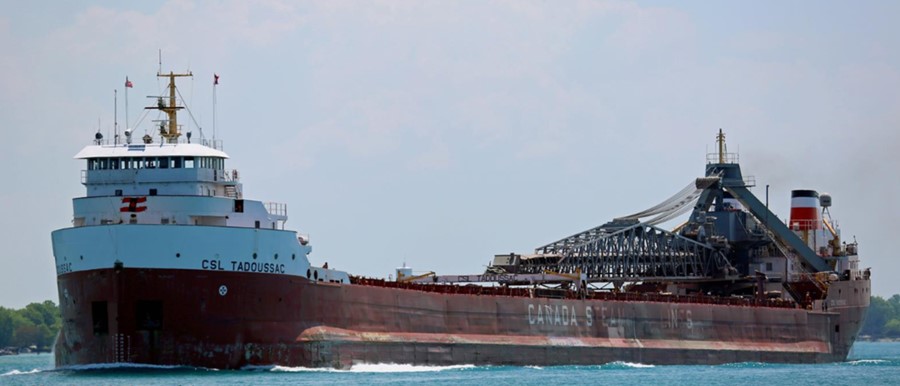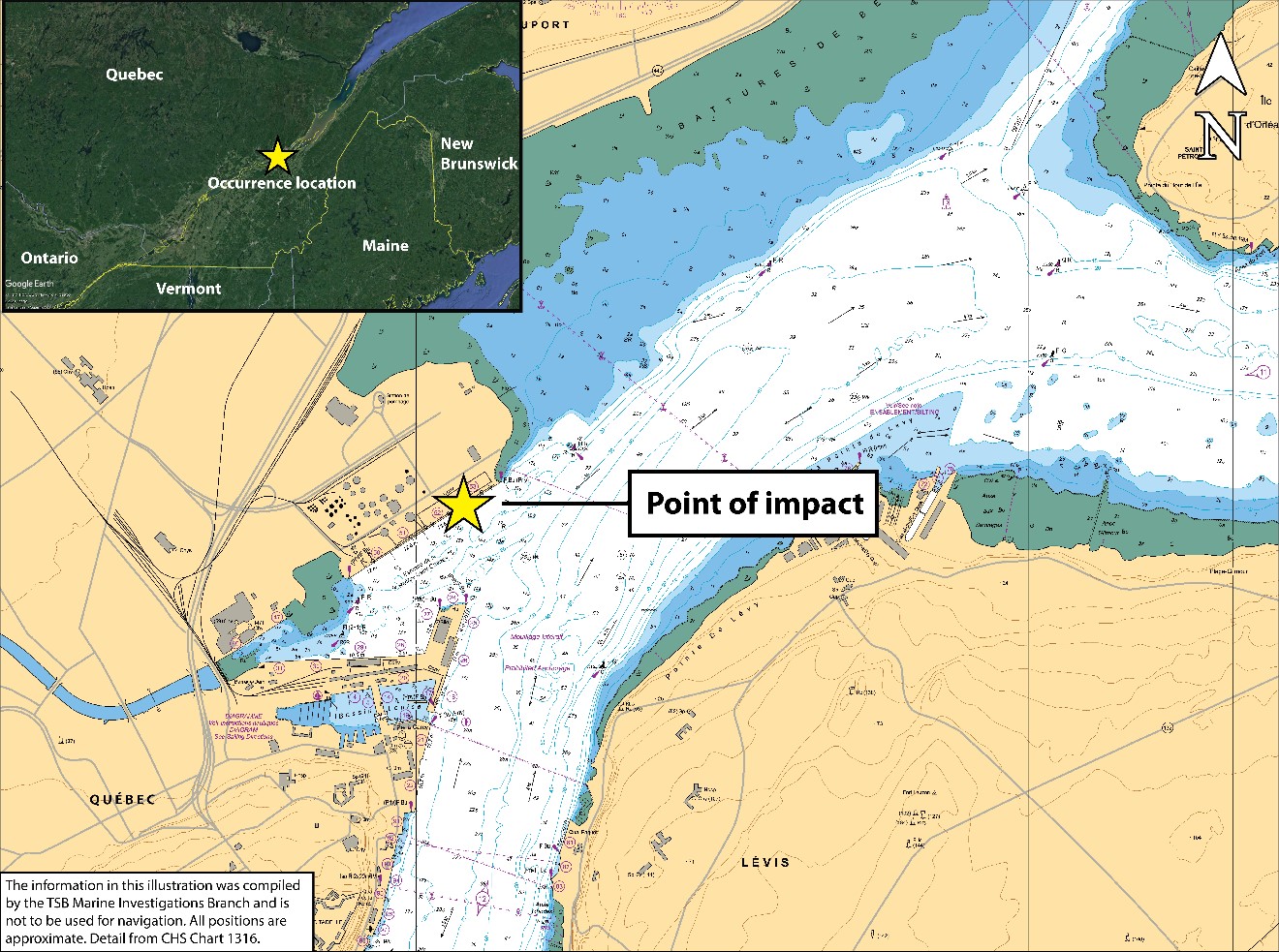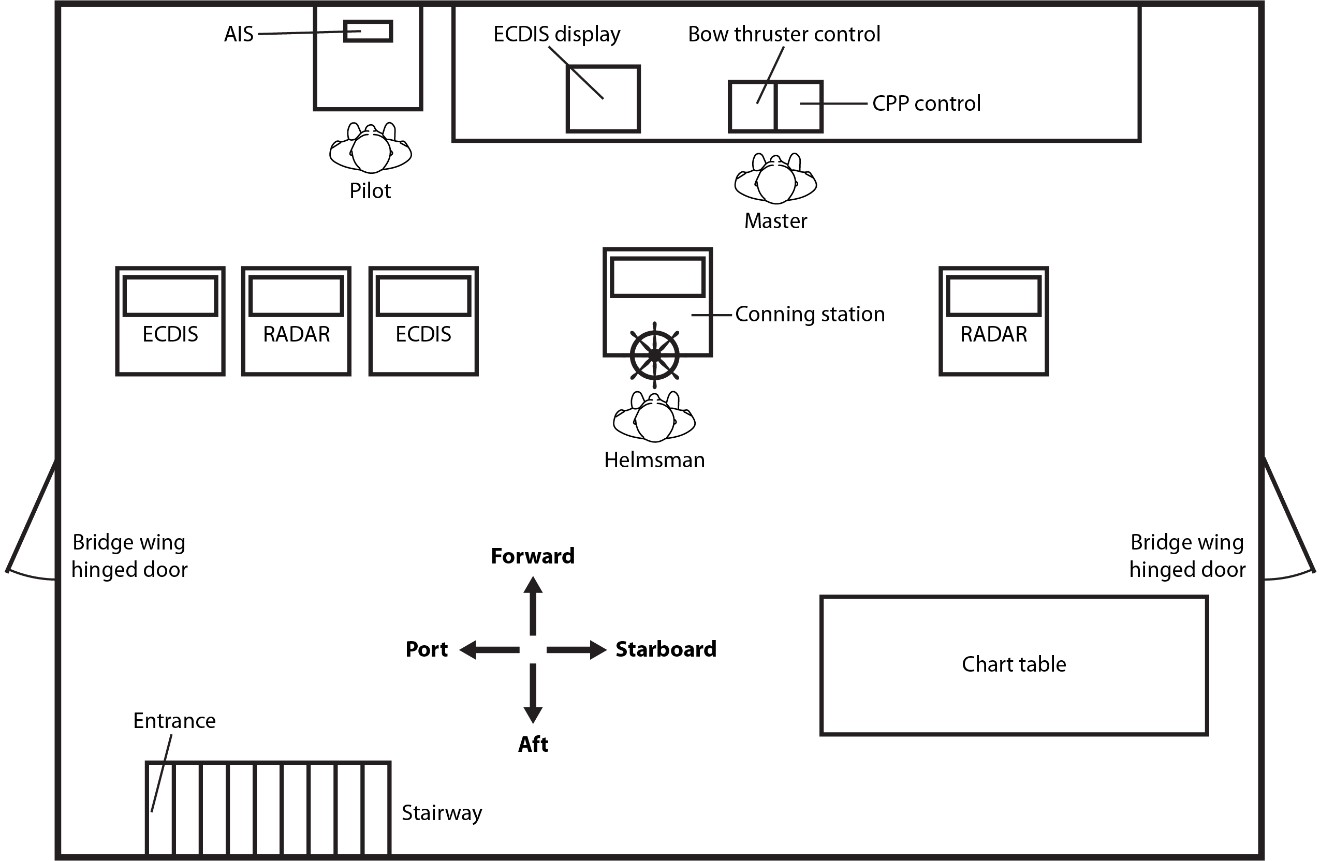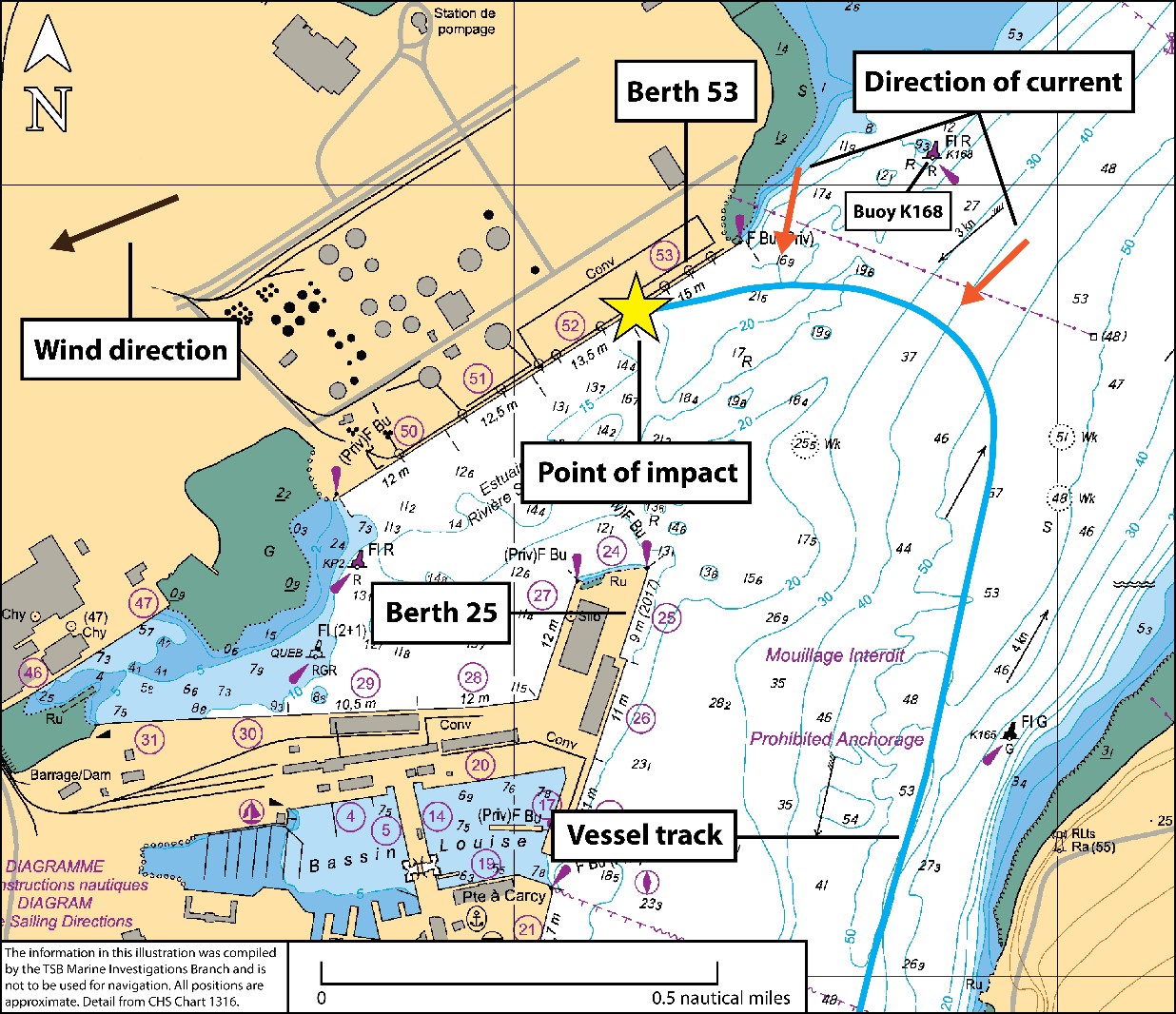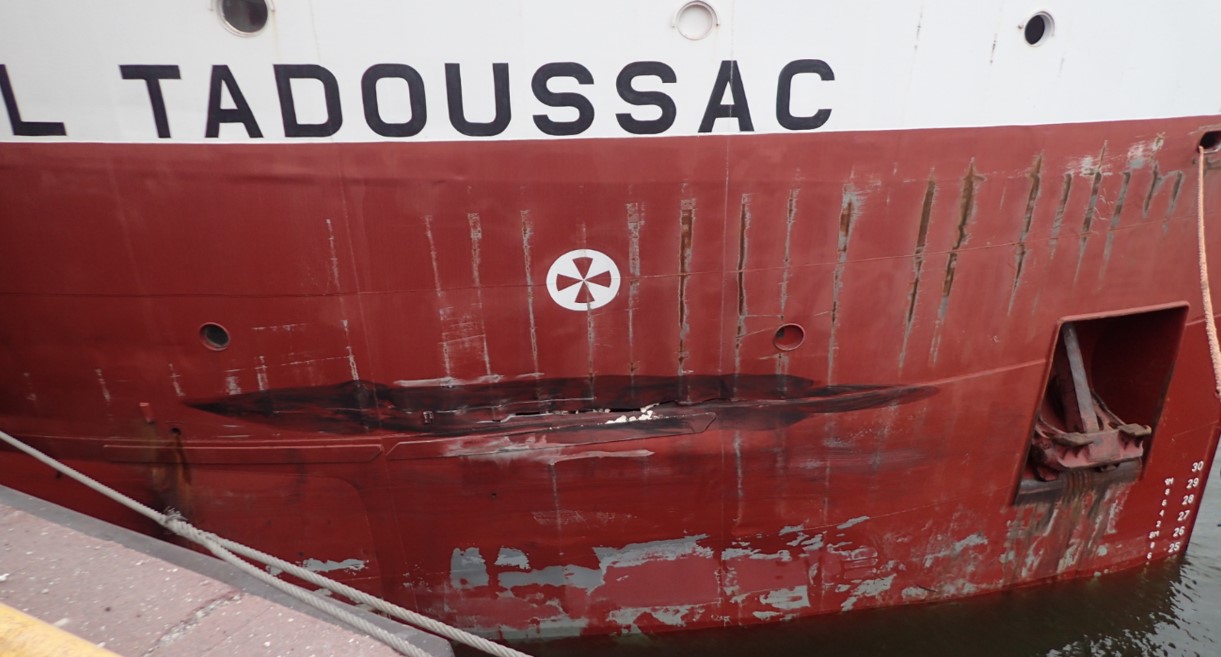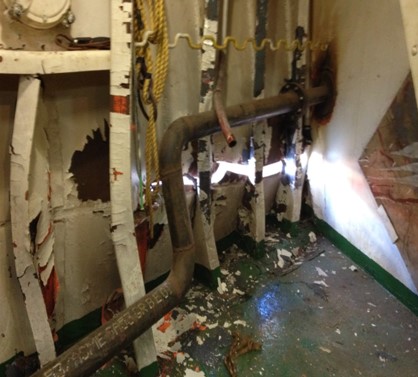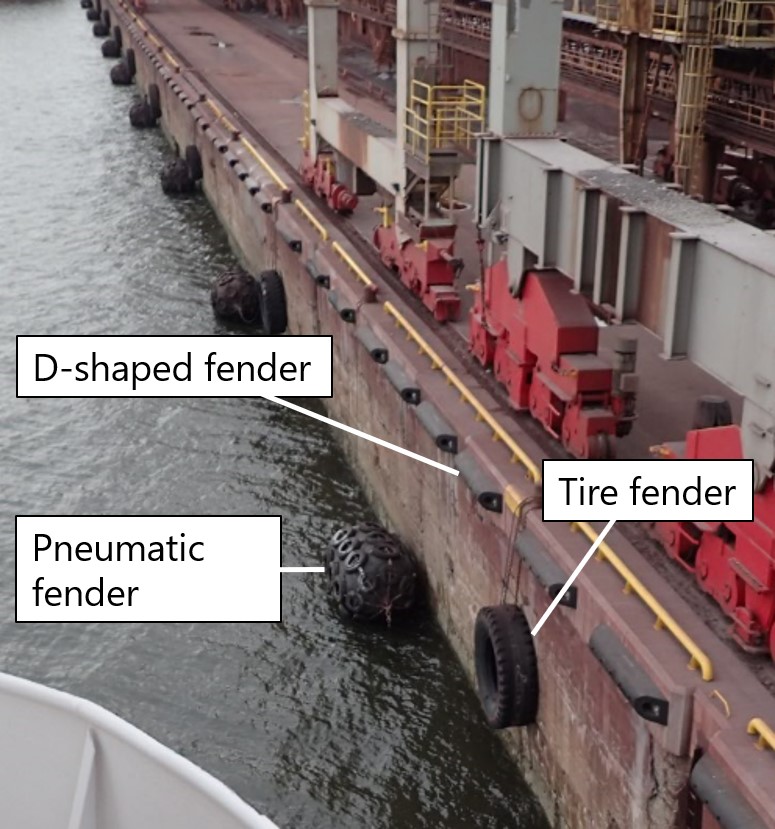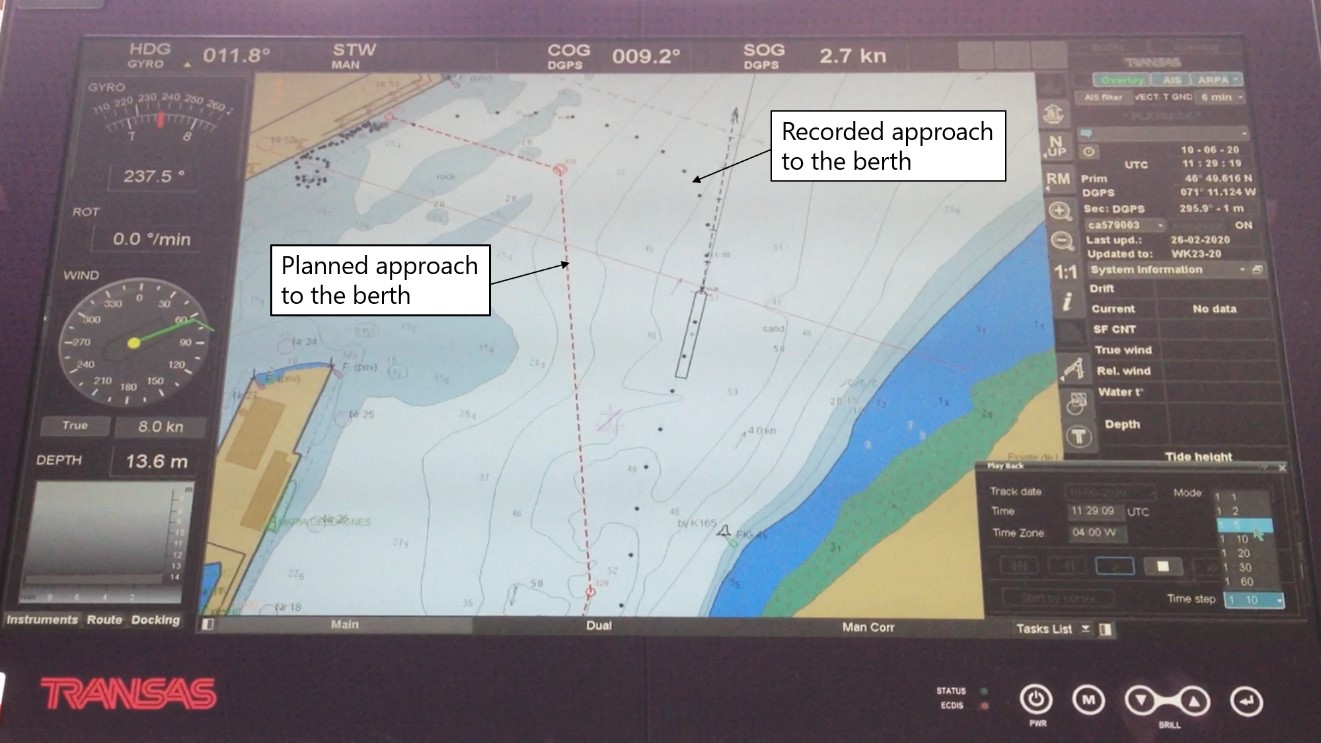Striking of berth
Bulk carrier CSL Tadoussac
Port of Québec
Québec, Quebec
The Transportation Safety Board of Canada (TSB) investigated this occurrence for the purpose of advancing transportation safety. It is not the function of the Board to assign fault or determine civil or criminal liability. This report is not created for use in the context of legal, disciplinary or other proceedings. See Ownership and use of content. Masculine pronouns and position titles may be used to signify all genders to comply with the Canadian Transportation Accident Investigation and Safety Board Act (S.C. 1989, c. 3).
Summary
On 10 June 2020, the bulk carrier CSL Tadoussac was berthing under the conduct of a pilot in the Port of Québec, Quebec, when the vessel struck the berth. The vessel was damaged. There were no injuries or pollution.
1.0 Factual information
1.1 Particulars of the vessels
| Name of vessel | CSL Tadoussac |
|---|---|
| International Maritime Organization number | 6918716 |
| Official number | 325750 |
| Flag | Canada |
| Port of registry | Collingwood, Ontario |
| Classification society | Lloyd’s Register |
| Type | Bulk carrier |
| Gross tonnage | 20 101 |
| Length overall | 222.6 m |
| Breadth | 23.78 m |
| Depth | 12.78 m |
| Maximum draft | 8.05 m |
| Deadweight | 30 133 t |
| Built | 1969 |
| Propulsion | 1 diesel engine of 6637 kW driving 1 left-handed controllable-pitch propeller |
| Bow thruster | 746 kW |
| Cargo | 27 013 t of iron ore |
| Crew | 24 |
| Owner | Canada Steamship Lines |
1.2 Description of the vessel
The self-unloading bulk carrier CSL Tadoussac was built in 1969 in Ontario by Collingwood Shipyards Ltd. In 2001, the vessel was widened and its self-unloading system updated by Canadian Shipbuilding & Engineering Ltd. in Port Weller, Ontario.
The vessel (Figure 1) is equipped with an on-board cargo handling system, allowing cargo to be discharged without shore-based unloading equipment. The vessel has a steel hull with a straight-stem bow and a flat transom stern. The CSL Tadoussac has forward and aft superstructures separated by 5 cargo holds. The navigation bridge and an accommodation are located forward. The engine room, machinery spaces, and another accommocation are located aft.
The bridge is equipped with communication and navigational equipment, including 2 electronic chart display and information systems (ECDIS) with 1 additional display, and 2 radars with automatic radar plotting aid capability. The main console is located close to the bridge’s front windows and has controls for the main engine (including for a controllable-pitch propeller) and bow thruster. The conning station is located behind the main console. To the port side of the main console there is another console with an automatic identification system (AIS), equipped with a pilot plug to connect a portable pilot unit (PPU).Footnote 1 There are 2 small bridge wings on either side of the bridge.
The vessel is propelled by a single 6-cylinder, 2-stroke diesel engine driving a left-handed controllable-pitch propeller.Footnote 2 This type of propeller rotates in a counter-clockwise direction. When the propeller pitch is set astern, the resultant thrust tends to pivot the vessel’s stern to port and its bow to starboard. Steering is effected using a balanced rudder with a maximum angle of 35°, and the vessel has a tunnel bow thruster with a power of 746 kW. The vessel is not fitted with a voyage data recorder.
The vessel has 3 anchors: 1 on either side of the bow, and 1 astern. The anchors are equipped with a manual brake and can only be released locally. At the time of the occurrence, all 3 anchors were ready to let go, as required for all vessels navigating within compulsory pilotage areas on the St. Lawrence River.
1.3 History of the voyage
On 07 June 2020, the CSL Tadoussac departed Conneaut, Ohio, United States, bound for Québec, Quebec. After departing the St. Lambert Lock in Montréal, Quebec, the vessel proceeded eastward under the conduct of a pilot.
On 10 June 2020, at 0150,Footnote 3 the vessel arrived at the pilot station in Trois-Rivières, Quebec, where a relief pilot embarked. The departing pilot and the relief pilot were both assigned by the Laurentian Pilotage Authority (LPA). Upon boarding, the relief pilot exchanged navigational information with the departing pilot, and had a discussion with the master concerning the vessel’s speed, destination at berth 53, and berthing the vessel on its starboard side. The pilot set up his PPU to monitor the vessel’s progress and reported the vessel’s estimated time of arrival at the next calling-in point (CIP) to Marine Communications and Traffic Services (MCTS) Québec. The officer of the watch (OOW) handed the pilot card to the pilot.Footnote 4 Shortly after, the master left the bridge; the bridge team then consisted of the pilot, an OOW, and a helmsman.
At 0629, the chief officer, who was the OOW at that time, called the master as the vessel entered Port of Québec limits (Figure 2).
At 0654, the pilot reported the vessel’s position to MCTS Québec and reduced the vessel’s speed. Shortly after, the master arrived on the bridge.
At 0700, following a short discussion between the master and chief officer about the upcoming berthing operation, the master relieved the chief officer, who then left the bridge.
Shortly after, the pilot explained his berthing plan to the master. The master then informed the pilot of the vessel’s manoeuvring particularities given that the vessel is equipped with a left-handed controllable-pitch propeller.
Before beginning the approach to berth 53, the pilot had positioned himself at the AIS console, facing the bridge windows, and was monitoring his PPU. The pilot provided helm orders to the helmsman and propulsion orders to the master. The helmsman was at the wheel, and the master operated the propulsion and bow thruster controls (Figure 3). From his position, the master was able to see the ECDIS display.
At approximately 0726, the vessel was abeam of berth 25. The vessel’s speed was 3 knotsFootnote 5 and its heading was 17° gyro.Footnote 6 To turn the vessel to port toward berth 53, the pilot ordered the rudder hard to port and the bow thruster to full power, also to port. The pilot then ordered the master to reduce the vessel’s speed (Figure 4).Footnote 7
By 0735, the vessel had completed half of its turning circle toward berth 53. Its speed at that time was 2.2 knots.
Shortly after, the pilot noticed visually and on the PPU that the vessel’s approach trajectory had changed; the predicted trajectory was no longer parallel to the berth as planned, but was on a collision course with it. The vessel’s rate of turn had noticeably slowed, and the vessel’s speed had increased to 2.7 knots.
At 0741, the vessel’s starboard bow passed abeam of the corner of berth 53. The vessel continued to slowly turn to port as it approached the berth at a speed of 3.2 knots. The vessel was positioned in such a way that the forward part of the vessel was lined up with the berth, while the aft part of the vessel extended past the berth.
At about 0742, while continuing to advance toward the berth at a speed of about 3 knots, the vessel had stopped turning to port. The collision with the berth was unavoidable, and so the pilot ordered the master to set the propeller pitch to full astern; however, the master had already done so shortly before hearing the order. The exact time of the master’s action could not be determined.
At about 0743, the vessel’s starboard bow hit berth 53 between 2 pneumatic floating rubber fenders at a speed of 2.1 knots and an angle of approximately 30°. One of the berth’s D-shaped rubber fenders punctured the vessel’s starboard bow.
After the striking, the pilot asked the master to complete the docking. The vessel was secured alongside berth 53 at 0840.
The pilot reported to MCTS Québec that the vessel was secured alongside the berth. MCTS Québec was not informed at that time that the vessel had collided with the dock, as required by regulations. Footnote 8
After evaluating the vessel damage with the master, the pilot disembarked.
At 1223, the vessel’s manager informed Transport Canada’s (TC’s) Québec office of the occurrence.
1.4 Damage
The vessel sustained the following damage (figures 5 and 6):
- A puncture in the vessel’s bow thruster compartment on the starboard side, between frames 236 and 243
- Deformation of water ballast tank No. 2, 850 cm above the bottom of the tank, between frames 166 and 175
- Rub marks, scratches, and paint discoloration where the vessel contacted the D-shaped rubber fender
1.5 Environmental conditions
On the day of the occurrence, the weather was clear and winds were from the east-northeast at 7 knots.
Low tide was at 0509, and the water level was predicted to be 0.6 m above chart datum. High tide was at 1003 with the water level at 5.2 m above chart datum. At the time of the occurrence, the water level was nearly 4.0 m above chart datum and the current was flooding.
When the current is flooding, there are generally 2 main current directions present in the area of the occurrence.Footnote 9 Around the time of the occurrence, the first current was setting in a southwest direction, at a rate of about 2 knots; the second current was setting in a south-southwest direction along the shoreline of Baie de Beauport, at a rate of less than 1 knot.
1.6 Port of Québec
The Port of Québec is the second-largest port in the province of Quebec and is managed by the Québec Port Authority. The port territory is divided into 6 sectors, 1 of which is the Beauport sector, situated in Baie de Beauport, in the Saint-Charles River estuary. The Beauport sector is a deep-water sector; its 4 berths (No. 50, 51, 52, and 53) provide a depth of 15 m at low tide, which can accommodate large cargo vessels.Footnote 10
1.6.1 Description of berth 53
Berth 53 is 325 m long; the apron extends 7.2 m above chart datum, and the water depth alongside is approximately 15 m. Tidal range can reach 6 m.
The berth is fitted with 3 different types of rubber fenders. The fenders are designed to absorb the energy that a vessel transfers to a berth, protecting the vessel’s hull and berthing structure. The berth’s fendering system (Figure 7) consists of:
- tire fenders, hanging on steel wires at 36.56 m intervals;
- pneumatic fenders approximately 2 m in diameter and 3.5 m long, anchored to the berth at 35.02 m intervals. These fenders have large compressive deformation energy absorption. The fenders float, so they can adapt to changes in tide; and
- hollow D-shaped fenders, horizontally bolted along the side of the berth.
1.6.2 Use of tugs
Vessels berthing at the Port of Québec must comply with Québec Port Authority requirements set out in the Practices and Procedures Related to Navigation. This document prescribes mandatory tug use for all vessels when berthing under 2 conditions:
- when the harbour master determines that wind exceeding 20 knots is impeding manoeuvres; and
- the vessel has a gross tonnage of 5000 or more and a deadweight over 5000 tons.Footnote 11
If the pilot or master determines that circumstances require it, a tug can be requested.
1.7 Vessel certification
The CSL Tadoussac carried all the required certificates under the Canada Shipping Act, 2001 for a vessel of its class and for the intended voyage. Although not required by regulation, the CSL Tadoussac had a safety management system (SMS) that was certified and audited by Lloyd’s Register.
1.8 Personnel certification and experience
The master of the CSL Tadoussac held a valid Master Near Coastal certificate, which was issued in 2009 and last renewed in 2019. He had sailed in various capacities, on different vessels, since 1975, and had worked with Canada Steamship Lines as master since 2003. The master had sailed on the CSL Tadoussac since 2018. The master had completed bridge resource management (BRM) training in January 1995. In addition, the master held a valid medical certificate.
The pilot held a valid Master Mariner certificate, issued in 2005. He had sailed in various capacities, on different vessels, since 1990, and completed a BRM course in November 2005. In 2007, after 2 years of apprenticeship, he was assigned as a pilot to the LPA’s District No. 1, for the Trois-Rivières to Québec sector. At the time of the occurrence, he held a Class A pilot licence, which allowed him to pilot vessels of any size within his sector. In addition, the pilot held a valid medical certificate.
The pilot was familiar with the Beauport sector of the Port of Québec.Footnote 12 He had manoeuvred different vessels in this sector 43 times before June 2020 and completed 14 assignments docking vessels at berth 53 in the previous 5 years, with the most recent being in April 2020. The pilot had not received an assignment on the CSL Tadoussac in the 5 years prior to this occurrence. The pilot completed several training courses on vessel manoeuvring as part of his pilotage training. In 2012, the pilot conducted simulated berthing manoeuvres at berth 53.
The helmsman had been sailing since 1975, and first joined the CSL Tadoussac as a helmsman in October 1980.
The investigation determined that there were no fatigue or medical factors affecting the master’s, pilot’s, or helmsman’s ability to navigate on the day of the occurrence.
1.9 Bridge resource management
BRM is the management and use of all resources, human and technical, available to the bridge team to ensure the safe completion of a voyage. Effective bridge communication is a central concept in BRM, because it enables bridge team members to develop a common understanding (or shared mental model) of how individual tasks will be carried out and how the voyage will progress overall. For BRM to be effective, information and intentions must be communicated and updated among bridge team members while the voyage progresses.
Effective communication is also fundamental to the master-pilot exchange, whereby the master and pilot discuss and agree on procedures, plans, manoeuvres, and contingencies before departure, and then continue to exchange navigational information for the duration of the voyage. Lack of communication can result in team members having different understandings of a situation as it unfolds.
The TSB’s studyFootnote 13 on the operational relationship between ship masters/watchkeeping officers and marine pilots examined 273 occurrences. A lack of communication between the pilot and the OOW was a factor that was frequently present. As part of the study, a survey of Canadian seafarers found that a significant proportion of masters and bridge officers reported some reluctance to question a pilot’s decisions. The study noted that, with respect to the overall exchange of information between pilots, masters, and OOWs, each party can be under the assumption that the other knows the necessary information and that, if they do not, they will request it.
A 2014 TSB online survey of 54 marine pilotsFootnote 14 found that, while they recognized the importance of effective communication and teamwork among bridge team members, 37% reported that the master almost never ensured that the passage plan and local conditions were suitable for the vessel, and 26% reported that bridge officers were almost always reluctant to question the pilot’s decisions.
1.9.1 Bridge resource management training requirements
As of 01 January 2005, the General Pilotage RegulationsFootnote 15 required all licensed marine pilots in Canada to hold a certificate of attendance from a BRM training program. In 2012, this requirement was repealed from the regulations and was not replaced.
However, the LPA still considers this training compulsory for its pilots.
Since 2017, based on the International Convention on Standards of Training, Certification and Watchkeeping for Seafarers (STCW), 1978 and the 2010 Manila Amendments,Footnote 16 Canadian seafarers who wish to obtain a certificate of competency as a mate are required to complete a Simulated Electronic Navigation Operational (SEN-O) course. Those wishing to obtain a certificate of competency as a master must complete a Simulated Electronic Navigation Management (SEN-M) Footnote 17 course. These courses replaced Simulated Electronic Navigation, Level 1 (SEN 1) and Simulated Electronic Navigation, Level 2 (SEN 2). The Marine Personnel Regulations Footnote 18 indicate that seafarers must take SEN 1 and SEN 2 to obtain their certificates of competency. The regulations do not mention SEN-O or SEN-M.
The SEN-O and SEN-M courses both include BRM training. BRM training topics generally include situational awareness,Footnote 19 communication skills, passage planning, bridge organization, leadership and teamwork, stress and fatigue, and bridge team member relationships with pilots and other crew members.
The SEN-O and SEN-M courses are described in the most recent version of TC publication TP 4958. This draft version was made available to authorized course providers in 2017. In 2018, the first SEN courses with BRM content were held.
At the time of report writing, neither the Marine Personnel Regulations nor the version of TP 4958 published on TC’s website had been updated with the 2017 changes to the STCW Convention regarding SEN courses that include BRM training.
The version of TP 4958 published on TC’s website still refers to Simulated Electronic Navigation, Levels 1 and 2, and does not include course content on BRM.
Masters and mates who obtained their certificates of competency before 2017 were not required to take a BRM course as part of their training. Furthermore, there are no regulatory requirements for masters and mates to complete the SEN-O and SEN-M courses, respectively, to renew their certificates of competency every 5 years.
1.10 Safety management
The objectives of the International Safety Management (ISM) CodeFootnote 20 are to ensure safety at sea, prevent human injury or loss of life, and avoid damage to the environment. According to the ISM Code, a company’s safety management objectives should provide for safe practices in vessel operations and a safe working environment by assessing all identified risks to vessels, personnel, and the environment; establish appropriate safeguards against those risks; and, continuously improve the safety management skills of personnel ashore and on board vessels. The ISM Code, which applies to all vessels subject to the International Convention for the Safety of Life at Sea (SOLAS), requires companies and vessels to develop and implement an SMS.
In Canada, non-Convention cargo vessels operating on domestic voyages are not required to have an SMS. However, companies that voluntarily implement an SMS may have it audited by a classification society. Upon verifying that the voluntary SMS meets the requirements of the ISM Code, and that the company and the vessel are operating in accordance with the SMS, the classification society will issue a document of compliance to the company and a safety management certificate to the vessel. TC does not provide verification or oversight of these voluntary systems.
Companies should ensure that the SMS used on board a particular vessel includes procedures and instructions to avoid unsafe practices in vessel operation. Accordingly, companies should keep their procedures simple and straightforward, and procedures should include routine operations such as passage planning and master-pilot exchange.Footnote 21
Although not required by regulation, Canada Steamship Lines had voluntarily developed an SMS for the CSL Tadoussac, and had contracted a classification society, Lloyd’s Register, to provide audit and certification of its compliance with the ISM Code.
1.10.1 Passage planning
A vessel’s passage plan is intended to enhance safety by highlighting high-risk areas and providing key information in a format that is readily available to those involved in the vessel’s navigation. A passage plan helps to create shared situational awareness among bridge team members as the voyage progresses. It also contains key navigational elements such as the vessel’s course, course alteration points with wheel-over positions, abort points,Footnote 22 local hazards, tides, visual cues and references, and points at which to report to the marine traffic control.
Subsection 14(1) of the Charts and Nautical Publications Regulations, 1995Footnote 23 indicates that all Canadian vessels, and all vessels in waters under Canadian jurisdiction, are required to prepare a berth-to-berth passage plan consistent with STCW A-VIII/2.3, IMO Resolution A.893 (21), and SOLAS Chapter V, Regulation 34.
The CSL Tadoussac’s passage planning procedure is described in the fleet operations manual, under the section on passage planning for vessels equipped with an ECDIS:
The passage plan from berth to berth should be cut in as many independent legs as necessary. For example, one file for the passage berth to out of coastal navigation, one file for the ocean passage and one file for the passage entering coastal waters to berth.Footnote 24
The same subsection contains a notice stating the following [emphasis in original]:
Masters and Navigating Officers must visually review each leg of the passage before it is used in Monitoring mode. It is also essential to make use of the in-built automatic checking functions provided when validating and approving the voyage plan.Footnote 25
A general passage plan from Conneaut to the Port of Québec was prepared well in advance of the occurrence voyage by a second officer and approved by the master. This general plan was input into the ECDIS, and was used for each voyage the vessel made from Conneaut to the Port of Québec. A paper version of this plan was printed and, per common practice, some details such as the voyage date and chart corrections were amended for the occurrence voyage. The berthing portion of the passage plan consisted of 2 legs and 3 waypoints, with the final waypoint at berth 53. The plan did not detail the manoeuvres required for the vessel to complete a turning circle and come alongside berth 53 (Figure 8).
To ensure that all essential elements are included in a passage plan, Canada Steamship Lines requires that its checklist be used in the passage planning procedure. According to this checklist, the abort points must be identified and marked. The passage plan checklist for the occurrence voyage was completed, indicating that the requirement to identify abort points had been fulfilled (Appendix A). However, the abort points had not been identified and marked on the passage plan.
1.10.2 Master-pilot information exchange procedure
The procedure for navigation under the conduct of a pilot on board the CSL Tadoussac is described in Part A of the fleet operations manual. Within this section, the manual requires masters and pilots to complete the Master / Pilot Exchange of Essential Information checklist. The laminated checklist used on board is shown in Appendix B; the checklist can be erased and reused for different voyages.
The checklist indicates that the master must give the pilot a safety briefing and the pilot card, which includes essential vessel information. The master also must inform the pilot of the vessel’s manoeuvring characteristics, status of the bridge equipment, air draft, and under-keel clearance.
The pilot must brief the master on the passage plan, including speed at critical stages. The pilot must also provide information on topics such as vessel traffic services reporting requirements, traffic conditions, tide and current data, and anticipated weather conditions.
Additionally, the checklist provides the items upon which the master and the pilot must agree: berth information, depth alongside, mooring plan, use of tugs and their rendezvous position, make fast position, bollard pull, any vessel restrictions, lines to be used when mooring and line handler arrangements.
The fleet operations manual further stipulates that [emphasis in original]:
On completion of the briefing, the Master must complete the Master/Pilot Exchange of Information Checklist NAV 05. This Record must be signed by the Master and the Pilot prior to proceeding. An appropriate Log entry is to be made. If the Pilot refuses to sign; an appropriate Log entry is to be made.
The pilotage must not commence until both the Pilot and the ship’s Bridge Team have been fully briefed and are fully aware of the situation. Commercial pressures must not be allowed to compromise proper passage planning. If the Master is not satisfied with the exchange of information or with the Pilot’s abilities, the vessel must not proceed.Footnote 26
The checklist was not completed or signed on the day of the occurrence as required. Not completing or signing the checklist on the day of the voyage was a common practice for master-pilot exchanges on board this vessel. The vessel logbook had no entries confirming that the master-pilot exchange procedure was carried out.
Based on IMO Resolution A960, the International Maritime Pilots’ Association recommends that the master and the pilot discuss their respective intentions and expectations regarding the anticipated passage and reach a “general agreement on plans and procedures, including contingency plans.” The document further cautions that “it should be clearly understood that any passage plan is a basic indication of preferred intention and both the pilot and the master should be prepared to depart from it when circumstances so dictate.”Footnote 27
1.11 Berthing a vessel on its starboard side
The following describes a common practice for berthing a vessel on its starboard side, without wind and current, that is fitted with a right-handed fixed-pitch propeller.Footnote 28 These procedures apply to vessels berthing in this manner at berth 53.
- Approach the berth at a steep angle.
- Put the rudder to port to swing the stern in toward the berth.
- Put the engine astern. When the engine is put astern to check the vessel’s way, the effect of transverse thrust will swing the stern away from the berth. Judgment is necessary to ensure that the effect of transverse thrust is sufficient to stop the swing to port but not sufficient to swing the stern away.
- Position the vessel parallel to the berth.Footnote 29
In addition to the above procedures, a vessel’s port anchor can be deployed to dredge the seafloor while berthing a vessel on its starboard side.
Different guides to ship handling provide slightly different information on optimal vessel velocity while approaching a berth. One handbook for master mariners refers to a velocity of 30 to 40 cm/s (0.6 to 0.8 knots) for vessels with a deadweight similar to that of the CSL Tadoussac.Footnote 30Approaching the berth at lower speeds can allow the vessel to be stopped using its engine or anchors, if necessary.
The manoeuvring of a large vessel can be affected by the wind, current, or a combination of both, as was the case the day of the occurrence. In these conditions, tug assistance can be useful in facilitating berthing.
Berthing a downbound vessel in the Beauport sector during a rising tide is more challenging than berthing an upbound vessel. Before entering the Saint-Charles River estuary, a downbound vessel must execute a turning circle to bring the vessel parallel to the berth line.Footnote 31 Vessel manoeuvres can be affected by the flooding southwest and south-southwest currents. The effect of the south-southwest current is most pronounced east of the corner of berth 53, at the extreme end of the terminal. Masters and pilots manoeuvring vessels in this area are aware of these currents’ effects.
1.11.1 Pilot’s berthing plan for berth 53
In this occurrence, the pilot’s berthing plan was as follows:
- While approaching the Beauport sector in the Saint-Charles River estuary, keep the vessel closer to the south shore of the St. Lawrence River to stay clear of berth 25, because the vessel could be pushed toward berth 25 by the southwest current.
- Reduce vessel speed to 2 or 2.5 knots to turn the vessel to port toward berth 53 and bring the vessel parallel to the berth at a distance of about 60 m.
- Move the vessel further along the terminal berth line to unoccupied berth 52. By bringing the vessel inside berth 52, the entire length of the vessel could be protected from the south-southwest current by the shore.
- Stop the vessel and then manoeuvre astern and forward to bring it alongside berth 53.
Tug assistance was not required by port regulations because the wind was less than 20 knots on the day of the occurrence. Although the pilot had the discretion to request tug assistance for berthing, the master and pilot did not discuss or plan for the possibility of tug assistance despite it being a checklist item.
The master, based on his experience with manoeuvring and berthing vessels in general and directly in the Beauport sector, preferred to approach berth 53 in parallel to it, completing the turn to port at lateral buoy K168 to account for the effect of the south-southwest current. Although the pilot’s planned approach differed from the master’s, the master did not express concerns about the pilot’s berthing plan.
1.12 Pilotage in the St. Lawrence River area
In Canada, there are 4 pilotage authorities, each of which is governed by the Pilotage Act. Footnote 32 The pilotage authorities operate in the following regions: Pacific, Great Lakes, Atlantic, and Laurentian. Each region has its own set of governing regulations.
The LPA is the federal Crown corporation responsible for providing pilotage services within the St. Lawrence River area. The LPA’s major responsibilities are establishing compulsory pilotage areas and issuing pilot licences and pilotage certificates. The LPA has contracts in place with 2 pilot corporations for licensed pilots and apprentice pilots who provide services in the following 3 districts:
- District No. 1, which covers the area between Montréal and Québec;
- District No. 1.1, which covers the Port of Montréal; and
- District No. 2, which covers the area between Québec and Les Escoumins, including the Saguenay River.
Pilotage services in districts No. 1 and 1.1 are provided by the Corporation des pilotes du Saint-Laurent Central (CPSLC), and pilotage services in District No. 2 are provided by the Corporation des pilotes du Bas Saint-Laurent.
The LPA contracts the training of apprentice pilots to the CPSLC, but retains the responsibility for ensuring pilots are duly trained and licensed.
Docking pilots perform berthing manoeuvres for vessels arriving in Québec from Les Escoumins. The docking pilot embarks at the pilot station off Sainte-Pétronille, Quebec, and relieves the pilot(s) already on board. This practice was adopted due to the size of District No. 2, which is 120 nautical miles (NM) and requires approximately 10 hours to transit. In comparison, the Trois-Rivières/Québec sector of District No. 1 is approximately 68 NM and requires approximately 6 hours to transit, so the pilots assigned to that district berth the vessels themselves.
1.12.1 Pilot and master responsibilities regarding the conduct of the vessel
To ensure safe navigation, it is essential that only one person have the conduct of a vessel at any given time. Otherwise, there may be conflicting orders and delayed decision making.
In compulsory pilotage areas, only a licensed pilot or pilotage certificate holder may have the conduct of a vessel, and this individual is responsible to the master for the safe navigation of the vessel.Footnote 33 If the master has reasonable grounds to believe that the pilot’s actions are endangering the safety of the vessel, the master can relieve the pilot from duty and take the conduct of the vessel. To do so, the master should inform the pilot of their intention to take conduct; transfers of conduct must be clear to ensure that the bridge team is aware of who is in control of the vessel. Under the Pilotage Act, when a master relieves a pilot, the master must send a detailed written report to TC within 3 days.Footnote 34
In August 2014, the LPA published a Notice to Industry to remind seafarers of the pilot’s role and responsibilities during berthing manoeuvres, and of the master’s responsibilities if the master relieves the pilot from duty. The notice also indicated that the master should inform the pilot and the bridge team when the master takes conduct of the vessel.
In this occurrence, the master set the propeller pitch to full astern before the pilot ordered him to do so, and without notifying the pilot.
1.12.2 Master-pilot information exchange requirements
The LPA has prepared a detailed policy on the exchange of information between masters and pilots. The LPA’s Policy on Master-Pilot Exchange (MPX)Footnote 35 came into effect on 23 June 2020, after this occurrence.
1.12.3 Portable pilot unit
A PPU is a computer-based portable electronic device that allows pilots to use their own electronic charts and routes to assist in the navigation of vessels. The PPU uses its own global positioning system antenna. The unit can be connected to the vessel’s AIS using the pilot plug. The PPU has a prediction function that projects the vessel’s future position(s) by performing geometric calculations based on the vessel’s current rate of turn, position, heading, course over ground, and speed over the ground. The PPU includes a function to record the voyage, however, this function must be activated by the operator. The pilot in this occurrence did not record the voyage; however, the LPA does not require its pilots to record their voyages.
The LPA provides each of its pilots with a PPU containing nautical charts for their respective pilotage areas. Recommended routes are not provided on the PPUs; the pilots are responsible for entering waypoints in the PPU to prepare the passage plan.
1.13 Voyage data recorder
The purpose of a voyage data recorder (VDR) is to record and safeguard critical information and parameters relating to the last hours preceding an incident, in order to help relevant authorities with their investigations into the causes and contributing factors of an occurrence.
In addition to bridge audio, a VDR continuously records data such as the time, vessel heading and speed, gyrocompass readings, alarms, VHF radiotelephone communications, radar and echo sounder indications, wind speed and direction, and rudder/engine orders and responses. The VDR’s save button must be activated following an occurrence for the data to be retrievable.
Per the Voyage Data Recorder Regulations,Footnote 36 the CSL Tadoussac was not required to be fitted with a VDR, and did not have one installed.
1.14 Active TSB recommendations
On 01 January 1995, the TSB released the final report on its Safety Study of the Operational Relationship Between Ship Masters/Watchkeeping Officers and Marine Pilots.Footnote 37 This study examined safety deficiencies associated with teamwork on the bridge, including communications between marine pilots and masters/OOWs on Canadian and foreign vessels with a gross tonnage of over 5000 that were under the conduct of pilots in Canadian pilotage waters.
The Board found that differences in perceptions and expectations between pilots and masters/OOWs contribute to a lack of mutual understanding between the groups. Because of the potentially serious consequences of these misunderstandings, the Board felt that strong measures were required to improve bridge team effectiveness through enhanced information exchange, and made 2 recommendations to that effect: one concerning a formal exchange of information between the master and the pilot before the pilot commences duty, and the other concerning training for Canadian pilots and ship officers to include practice on handover procedures.
Therefore, the Board recommended that
[t]he Department of Transport require that the initial training syllabus for all ship officers be modified to include demonstration of skills in Bridge Resource Management.
TSB Recommendation M95-09
The Board also recommended that
[t]he Department of Transport require that all ship officers demonstrate skills in Bridge Resource Management before being issued Continued Proficiency Certificates.
TSB Recommendation M95-10
Since these recommendations were issued, the TSB has followed up annually with TC on action being taken to address them. TC provides responses indicating what actions have been or will be taken, and the TSB assesses those responses. At the time of report writing, TC’s most recent responses were received in February 2021. The Board considered the response to Recommendation M95-09 to show Satisfactory Intent,Footnote 38 and the response to Recommendation M95-10 to be Satisfactory in Part.Footnote 39
1.15 TSB Watchlist
The TSB Watchlist identifies the key safety issues that need to be addressed to make Canada’s transportation system even safer.
Safety management is a Watchlist 2020 issue. Although an SMS is not required by regulation on vessels such as the CSL Tadoussac, Canada Steamship Lines had voluntarily developed and implemented an SMS for the CSL Tadoussac and had contracted Lloyd’s Register to provide oversight and certification.
TC does not audit voluntary SMSs on Canadian vessels, and TC’s post-occurrence inspection of the CSL Tadoussac did not record any deficiencies in the SMS. However, the TSB’s investigation into this occurrence identified gaps in adherence to the passage plan and master-pilot exchange, which are part of the vessel’s SMS. This highlights the importance of adequate regulatory surveillance and of operators demonstrating that their SMS is effective.
ACTIONS REQUIRED
|
2.0 Analysis
The analysis will focus on the factors leading to the striking of berth 53 in the Port of Québec, including the effect of currents and wind, the vessel’s speed, and the ineffectiveness of avoidance manoeuvres. It will also discuss the role of bridge resource management (BRM), transfer of conduct, procedures for passage planning and the master-pilot information exchange, and the use of voyage data recorders (VDR).
2.1 Factors leading to the striking
After the CSL Tadoussac entered the Beauport sector of the Port of Québec, the pilot engaged in a turning manoeuvre at a speed over the ground of 3.2 knots to complete a turning circle to port. The pilot’s goal was to bring the vessel parallel to the berth line at a distance of about 60 m, and then manoeuvre the vessel to bring it alongside berth 53. The pilot relied on his portable pilot unit’s (PPU’s) prediction function to monitor the vessel’s progress and help navigate during the berthing. When the forward part of the CSL Tadoussac passed abeam of the corner of berth 53, the vessel was positioned in such a way that it was partly inside the berth. While the forward part of the vessel’s hull was protected from the south-southwest flood tide current, its aft extended past the berth and was exposed to the current. The force of the current pushed the stern to port, causing the bow to move starboard, toward the berth.
The pivoting moment created by the current acted against the turning moment created by the vessel’s rudder and bow thruster, reducing the vessel’s rate of turn. Consequently, the vessel was unable to complete its port turn and was not parallel as it approached the berth.
The vessel approached the berth at reduced speed, but its headway was affected by the combined effect of the southwest current and the east-northeast wind, which pushed the vessel forward.
As a result of the incomplete turn to port and the combined effect of the current and wind, the vessel approached the berth at a speed of about 3 knots, limiting the time available for the crew to take effective corrective action to prevent the vessel from striking the berth.
In an attempt to avoid striking the berth, the master set the left-handed controllable-pitch propeller to the full astern position. This action torqued the vessel’s stern to port, reducing the vessel’s rate of turn to port. Consequently, the vessel’s course over ground gradually changed to starboard and its speed reduced to 2.1 knots. The vessel thenapproached the berth at an angle of 30°, which contributed to the vessel missing a pneumatic fender and striking the berth.
Just before the CSL Tadoussac struck the berth, its speed was approximately 2 knots; it was therefore not possible to stop the vessel using the engine alone. In such situations, where a vessel is in close proximity to a berth and travelling at a speed that does not allow it to be stopped using the engine alone, dropping and dredging the anchor may help to reduce speed and cant the bow away from the berth. This action may help avoid striking or minimize damage to the vessel.
Before the occurrence, the pilot and master did not discuss or plan the use of anchors for berthing or in an emergency. Consequently, although the anchors had been readied for release, no crew members were assigned to stand by to release them.
The CSL Tadoussac was not required by port authority regulations to use tug assistance. Although tug assistance could be requested for berthing, the master and pilot did not plan to use a tug.
If masters and pilots do not consider and discuss the use of all available means to manoeuvre when berthing, such as anchors or tug assistance, they risk limiting the tools available to them, especially in critical moments.
2.2 Bridge resource management
BRM is effective only when a team shares a similar understanding of a situation. Lack of communication can have detrimental effects on team situational awareness and therefore on the safe and effective transit of a vessel. BRM training highlights the necessity of shared situational awareness and communication between bridge team members, notably communication between masters and pilots. This type of training can mitigate the risk of inadequate communication. Before this occurrence, the pilot had completed BRM training in 2005, and the master had completed BRM training in 1995.
In this occurrence, there were instances where a lack of communication between the master and pilot diminished their potential to develop and share an accurate situational awareness of the vessel’s trajectory during the berthing manoeuvre. The pilot explained his planned approach and berthing manoeuvres to the master; the master acknowledged the plan and informed the pilot of the vessel’s manoeuvring characteristics. However, from previous experience berthing in the Beauport sector, the master had a different preferred approach than that of the pilot for manoeuvring the vessel to the berth, but he did not communicate this preference to the pilot.
There can be a reluctance among bridge crew members to question a pilot’s decisions, and a tendency to rely on the pilot’s local knowledge and experience when performing berthing manoeuvres. However, a master and crew have greater familiarity with and knowledge of the manoeuvring characteristics of their vessel, and it is important to share crucial information with pilots when planning and executing a manoeuvre. The investigation could not determine the extent to which the pilot might have modified the approach had the master shared his experience manoeuvring the vessel and his preferred approach to berth 53.
In this occurrence, the pilot had conduct of the vessel. However, when it became evident to the master that a collision with the berth was unavoidable and that urgent action was warranted, he attempted an avoidance manoeuvre by setting the propeller pitch to full astern. The master did not communicate his action to the pilot, thereby limiting the accuracy of the pilot’s situational awareness and his understanding of the vessel’s evolving trajectory.
With his action, the master effectively relieved the pilot from duty and took conduct of the vessel. Even if the master believed that the pilot’s actions endangered the safety of the vessel, per the Pilotage Act and the Laurentian Pilotage Authority, he had to clearly notify the pilot of his intention to take conduct of the vessel.
If bridge team members do not consistently communicate to establish a shared understanding of a vessel’s status, there is a risk that crucial manoeuvres to ensure safe navigation will not be adequately planned, coordinated, and executed.
2.3 Safety management on board the CSL Tadoussac
Canada Steamship Lines had voluntarily developed a safety management system (SMS) for the CSL Tadoussac that included procedures and instructions for routine operations such as passage planning and master-pilot information exchange. However, on the day of the occurrence, some of these procedures were not strictly followed.
A passage plan is a formal procedure intended to provide the bridge team with a prospective view of the upcoming manoeuvres necessary to ensure the safe passage of the vessel. The passage plan must be realistic and closely match the actual waterways and vessel manoeuvring characteristics to be practically applicable.
To adhere to the requirements of passage planning contained in the vessel’s SMS, a general passage plan for the vessel’s routine voyage from Conneaut to the Port of Québec had been prepared, which was approved by the master. The berth approach portion of the general passage plan consisted of 2 legs and 3 waypoints, with the last waypoint on the berth.
Although the general passage plan technically met the berth-to-berth requirements of the SMS, the berth approach portion had the vessel approaching head on, which did not accurately portray the master’s preferred route, nor the pilot’s planned route. This portion of the passage plan was not divided into multiple independent legs that follow the common and practical vessel approaches and manoeuvres necessary for berthing at berth 53, such as the turning circle required to bring the vessel parallel to the berth.
Consequently, the bridge team could not adhere to the vessel’s passage plan and had to rely entirely on the pilot to safely berth the vessel. Having a pilot on board does not relieve a bridge team of the requirement to prepare a realistic passage plan that includes a practical berth approach. Furthermore, without a full understanding of the pilot’s passage plan, the bridge team did not have a predictive understanding of the upcoming manoeuvres and was therefore unable to monitor the pilot’s actions as the vessel approached the berth.
If a vessel passage plan does not include a realistic berth approach that integrates actual conditions and vessel characteristics, there is a risk that bridge team members will not establish a shared mental model and therefore be unable to effectively monitor and anticipate the vessel’s progress during the berthing manoeuvre.
A master-pilot exchange is intended to share essential information regarding navigation and the vessel’s characteristics. Information exchange also allows all bridge team members to have the same mental model of the vessel’s passage plan.
In this occurrence, the pilot exchanged navigational information with the departing pilot, and had a discussion with the master concerning the vessel’s speed and its destination. The master and the pilot did not complete and sign the Master / Pilot Exchange of Essential Information checklist as required by the vessel’s procedures. The checklist is an important tool to use during the formal master-pilot exchange, as it is intended to help both parties share all necessary and critical information. Because the exchange was not conducted in accordance with standard procedures, essential information was not shared between the master and the pilot; as the vessel approached berth 53, the master and the pilot did not discuss a contingency plan.
If masters and pilots do not follow the established procedure on master-pilot information exchange, they risk not sharing essential information, such as vessel characteristics, required for safe navigation.
2.4 Voyage data recorder
Objective VDR data are invaluable to investigators when they attempt to understand a sequence of events and identify operational problems and human factors.
In this occurrence, the CSL Tadoussac did not have a VDR on board, nor was one required by regulation. Consequently, investigators could not confirm engine orders and response times. In the absence of VDR bridge audio recordings, the investigation was unable to objectively confirm some of the events leading up to the striking.
If VDR data are not available to an investigation, this may preclude the identification and communication of safety deficiencies to advance transportation safety.
3.0 Findings
3.1 Findings as to causes and contributing factors
These are conditions, acts or safety deficiencies that were found to have caused or contributed to this occurrence.
- The pivoting moment created by the current acted against the turning moment created by the vessel’s rudder and bow thruster, reducing the vessel’s rate of turn. Consequently, the vessel was unable to complete its port turn and was not parallel as it approached the berth.
- As a result of the incomplete turn to port and the combined effect of the current and wind, the vessel approached the berth at a speed of about 3 knots, limiting the time available for the crew to take effective corrective action to prevent the vessel from striking the berth.
- In an attempt to avoid striking the berth, the master set the left-handed controllable-pitch propeller to the full astern position. This action torqued the vessel’s stern to port, reducing the vessel’s rate of turn to port. Consequently, the vessel’s course over ground gradually changed to starboard and its speed reduced to 2.1 knots. The vessel then approached the berth at an angle of 30°, which contributed to the vessel missing a pneumatic fender and striking the berth.
3.2 Findings as to risk
These are conditions, unsafe acts or safety deficiencies that were found not to be a factor in this occurrence but could have adverse consequences in future occurrences.
- If masters and pilots do not consider and discuss the use of all available means to manoeuvre when berthing, such as anchors or tug assistance, they risk limiting the tools available to them, especially in critical moments.
- If bridge team members do not consistently communicate to establish a shared understanding of a vessel’s status, there is a risk that crucial manoeuvres to ensure safe navigation will not be adequately planned, coordinated, and executed.
- If a vessel passage plan does not include a realistic berth approach that integrates actual conditions and vessel characteristics, there is a risk that bridge team members will not establish a shared mental model and therefore be unable to effectively monitor and anticipate the vessel’s progress during the berthing manoeuvre.
- If masters and pilots do not follow the established procedure on master-pilot information exchange, they risk not sharing essential information, such as vessel characteristics, required for safe navigation.
- If voyage data recorder data are not available to an investigation, this may preclude the identification and communication of safety deficiencies to advance transportation safety.
3.3 Other findings
These items could enhance safety, resolve an issue of controversy, or provide a data point for future safety studies.
- The pilot reported to Marine Communications and Traffic Services (MCTS) Québec that the vessel was secured alongside the berth. MCTS Québec was not informed at that time that the vessel had collided with the dock, as required by regulations.
- As of 01 January 2005, the General Pilotage Regulations required all licensed marine pilots in Canada to hold a certificate of attendance from a bridge resource management training program. In 2012, this requirement was repealed from the regulations and was not replaced.
- At the time of report writing, neither the Marine Personnel Regulations nor the version of TP 4958 published on Transport Canada’s website had been updated with the 2017 changes to the International Convention on Standards of Training, Certification and Watchkeeping for Seafarers regarding Simulated Electronic Navigation courses that include bridge resource management training.
- Masters and mates who obtained their certificates of competency before 2017 were not required to take a bridge resource management course as part of their training. Furthermore, there are no regulatory requirements for masters and mates to complete the Simulated Electronic Navigation Operational and Simulated Electronic Navigation Management courses, respectively, to renew their certificates of competency every 5 years.
4.0 Safety action
4.1 Safety action taken
4.1.1 Laurentian Pilotage Authority
The Laurentian Pilotage Authority (LPA) conducted a case study of this occurrence and sent letters to the pilot and the master informing them of the study’s conclusions.
Before this occurrence, the LPA had prepared a detailed policy on the exchange of information between masters and pilots, entitled Policy on Master-Pilot Exchange (MPX), which came into effect on 23 June 2020. Following this occurrence, this policy was sent to the pilot and the master at the same time as the study’s conclusions.
This report concludes the Transportation Safety Board of Canada’s investigation into this occurrence. The Board authorized the release of this report on . It was officially released on .
